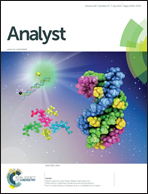A sensitive biosensor with a DNAzyme for lead(ii) detection based on fluorescence turn-on†
Abstract
In this paper, we described a new DNAzyme-based fluorescent biosensor for the detection of Pb2+. In the biosensor, the bulged structure is formed between the substrate labeled with fluorescein amidite (FAM) and DNAzyme after being annealed. Ethidium bromide (EB), the DNA intercalator, then intercalates into the double-stranded DNA section. Once FAM is excited, the FRET takes place from FAM to EB, which leads to the fluorescence of FAM decreasing greatly. In the presence of Pb2+, the substrate is cleaved by DNAzyme, which breaks the bulged structure. Then EB is released and the FRET from FAM to EB is inhibited. In this case, the fluorescence of FAM increases dramatically. Thus, the Pb2+ ions can be detected by measuring the fluorescence enhancement of FAM. Under optimal conditions, the increased fluorescence intensity ratio of FAM is dependent on the lead level in the sample, and exhibits a linear response over a Pb2+ concentration range of 0–100 nM with a detection limit of 530 pM. The sensor showed high selectivity in the presence of a number of interference ions. The river water samples were also tested with satisfying results by using the new method. This sensor is highly sensitive and simple without any additional treatments, which provides a platform for other biosensors based on DNAzyme.


 Please wait while we load your content...
Please wait while we load your content...